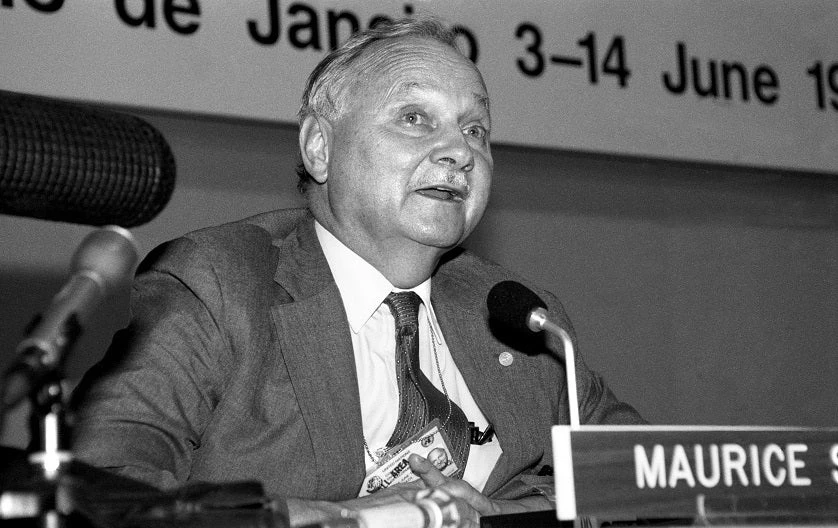
Today at the COP21 climate talks in Paris, people will gather and pay tribute to the life, vision and accomplishments of Maurice Strong who passed away November 27, 2015 on the eve of COP 21.
When he died in Ottawa at the age of 86, the world lost a crucial voice on the global environment and the urgent need for climate action. Ironically, Strong died on the eve of the Paris climate conference - for which he had laid the foundation over the last 45 years. With his death, we lost a giant in the environment and climate change movement.
Maurice’s resume could have been that of five men. He moved seamlessly between the private and public sectors all of his life―starting his career in the oil patch, becoming Vice President of Dome Petroleum; later President of Power Corp of Canada and the inaugural chief of the Canadian oil agency, Petro Canada.
But it was the good fortune of the world that from his earliest years Strong was drawn to public service and to the United Nations. He was appointed the first leader of CIDA, the Canadian International Development Agency; UN Secretary General of the 1972 Stockholm Conference on the Environment; first head of UNEP, the UN Environment Program; in charge of the UN Famine Relief Program in Africa in the mid-1980s; and in 1992, UN Secretary General of the Rio Earth Summit which produced agreement on conventions on Climate Change and Biodiversity and launched a process which produced a Convention on Desertification. In 1995, Strong was appointed senior advisor to the then new president of the World Bank, Jim Wolfensohn. He was instrumental in shaping Bank policy on the environment and expanding dialogue with civil society.
With all these credentials, you could almost imagine Maurice Strong as bigger than life. But no, he was really life itself. He believed passionately that individuals and governments could work together for the good of the future and the earth. He eloquently articulated the issues of climate change before they became commonplace in the halls of power. He talked about the disparity between the developing world that was just trying to survive and the rich world that had spent a large proportion of what the earth had to offer.
More than anything else, Strong will be remembered as the man who globalized the environment and climate change, as the man who brought the world’s leaders to the table on the issues and put those often difficult issues on the international agenda. He made countries realize that they had a stake in the global environment and the world’s future had a stake in what individual countries did to deal with these issues. He was also the first UN organizer to give civil society a voice at the formal climate debate. Strong was the consummate event planner. He married pragmatism with idealism. He convinced civil society and government that we could do better and be more than the sum of our parts. As Secretary General of the first global conference on the environment in 1972 in Stockholm which put the environment on the international agenda, and then 20 years later at the Rio Earth Summit, Strong lay the groundwork for the Kyoto Protocol and for the next chapter that is being negotiated in Paris right now.
It would have been hard to imagine him in that role when he was growing up in the tiny town of Oak Lake Manitoba in 1929 on the cusp of the Great Depression. His family lived in the grinding poverty of those years. Strong recounted a story that as a young boy he would walk along the railroad tracks picking up pieces of coal that had fallen from trains to bring home to heat the family house. At 14 he hopped a freight train to try to make a better life. He spent time in the Canadian North living with Inuit; and made his way to Winnipeg where he managed to be taken on as an intern in an oil company. His early years in poverty shaped the man he would become—compassion and a humble demeanor identified him throughout his life giving him an uncanny ability to relate to both heads of governments and the poorest of people. He never forgot his early years and he put poverty reduction at the top of any agenda.
As former UN Secretary General Kofi Annan said of Strong in the foreword to Strong’s 2000 book “Where on Earth are We Going?” “If the world succeeds in making a transition to truly sustainable development, all of us will owe no small debt of gratitude to Maurice Strong, whose prescience and dynamic presence on the international stage have played a key role in convincing governments and grassroots alike to embrace the principle—if not yet the practice—of adopting a new long-term custodial approach to the global environment”.
At the Rio Earth Summit in 1992, I saw close up how Maurice Strong brought the world together. (Strong had borrowed me from the Canadian Broadcasting Corporation to work as his media advisor). He had convinced more than 118 heads of government to attend the conference. He saw the stakes clearly for the future of the planet and the human endeavor. He pointed out “We’re either going to save the world, or no one will be saved.”
When I went to work for Maurice Strong he told me the rules of the road which was the way he operated with everyone. He said “You can bring problems to me Anita, but you have to bring the solutions with them”. That advice has guided my thinking over the last 25 years. Let’s hope the negotiators at the Paris climate talks heed Maurice Strong’s words as they make decisions that will literally determine the human future on the Earth.


Join the Conversation